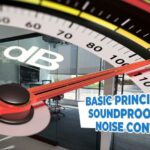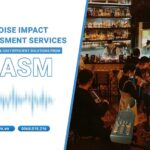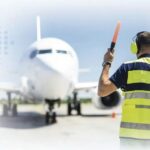Test for Rating of sound insulation in buildings and of building elements –Airborne sound insulation helps simplify the development of sound code requirements; proactively control quality during the production process and optimize research and development of building elements.
Overview of the Test for Rating of sound insulation in buildings and of building elements –Airborne sound insulation
Test name: Test for Rating of sound insulation in buildings and of building elements –Part 1: Airborne sound insulation.
Test method: ISO 717-1:2020: Acoustics – Rating of sound insulation in buildings and of building elements – Part 1: Airborne sound insulation [1].
Conducted at: Laboratory, the Institute of Development & Application for Sound Materials (DASM)
1. Test target and subjects
– Test target
- Determination of single numerical quantities for airborne sound insulation in buildings and building components such as walls, floors, doors and windows.
- Consider the different sound level spectrum of different noise sources, such as noise sources inside the building and traffic outside the building.
- Give rules for determining these quantities from the results of measurements made in the one-third octave or octave range, for example according to ISO 10140-2 and ISO 16283-1.
- A number adapted from this document to evaluate airborne sound insulation and to simplify the development of acoustic requirements in building codes. Evaluation of an additional number in 0.1dB steps is indicated to indicate uncertainty (except for spectral adaptation terms). The required numeric values of a number quantity are specified according to different needs. Numerical quantities based on measurement results in one-third octave range or octave range.
- For laboratory measurements carried out in accordance with ISO 10140-2, single quantities are calculated using one-third octave bands only.
– Test subjects
Evaluate the sound insulation of certain structures in new or renovating constructions using a single weight instead of a conventional air sound insulation curve according to ISO 10140-2 and ISO 16283-1.
2. Experimental procedures
Experimental procedure used for experiments with impedance tubes.
Steps:
- Prepare and arrange equipment and materials for testing.
- Equip the laboratory according to ISO 10140-2.
- Perform testing.
- Processing and reporting results
Role – importance of Rating of sound insulation in buildings and of building elements –Part 1: Airborne sound insulation
Test for Rating of sound insulation in buildings and of building elements – Part 1: Air sound insulation conducted by the Institute of Development & Application for Sound Materials helps meet all practical needs of customers, businesses meet all practical needs of customers, businesses, and units:
Meeting soundproofing standards for projects and construction items.
Controlling quality during production.
Optimizing research and development of soundproofing capabilities for materials and products used in construction projects/items.
Getting an factual basis to propose and implementing solutions that prioritize appropriate materials, products, machines, systems… that possess effective soundproofing capabilities in construction projects/items construction process.
Providing certificates and test results to increase competitiveness – sales, or put products into installation, use, construction… in works and projects in a convenient and transparent way.
Simplifying the development of acoustic requirements in building codes.
In addition, if the test sample does not meet the standards, DASM will consult and design solutions for shape/structure/materials used to calibrate the design in a streamlined, effective, and cost-saving manner.
In the past, if you still had some concerns and wonders about spending a lot of money for similar acoustics services abroad, now you just need to contact with DASM. We will proactively carry out the entire remaining process in the fastest possible time to perfect the customer experience with us: DASM provides acoustics consulting services with truly outstanding quality and the most competitive fees in the industry along with excellent customer service policies.
Meaning of acoustic testing service at DASM
Today, globalized commercial life creates countless new markets and sources of supply across the world. To walk along them would be international regulations and standards to help customers easily assess the quality – trace the product’s origin, choose suitable / superior products. In particular, they also support manufacturers to constantly improve and better technology, techniques, materials, production methods, sales, etc.
The Institute of Development & Application for Sound Materials (DASM) is a pioneering, comprehensive, professional and prestigious brand in Vietnam in the field of acoustics. On January 12, 2023, DASM was granted a certificate No. 114/TĐC – HCHQ by the Directorate for Standards, Metrology and Quality (Ministry of Science and Technology) on certification of testing activities registration for multidisciplinary synthesis in the field of Mechanics (registration number: 707/TN – TDC).
Our acoustic testing services help customers get accuarate practical results which meet sustainability, standard performance. We also offer solutions – consulting – adjusting designs … to optimise products and services. As a result, you will update, meet and adapt to ever-changing international standards to break through in revenue, profit and elevate your brand.
If you need to perform a Test for Rating of sound insulation in buildings and of building elements –Airborne sound insulation, please contact the Hotline for detailed advice!







